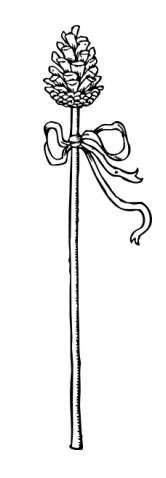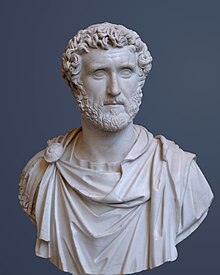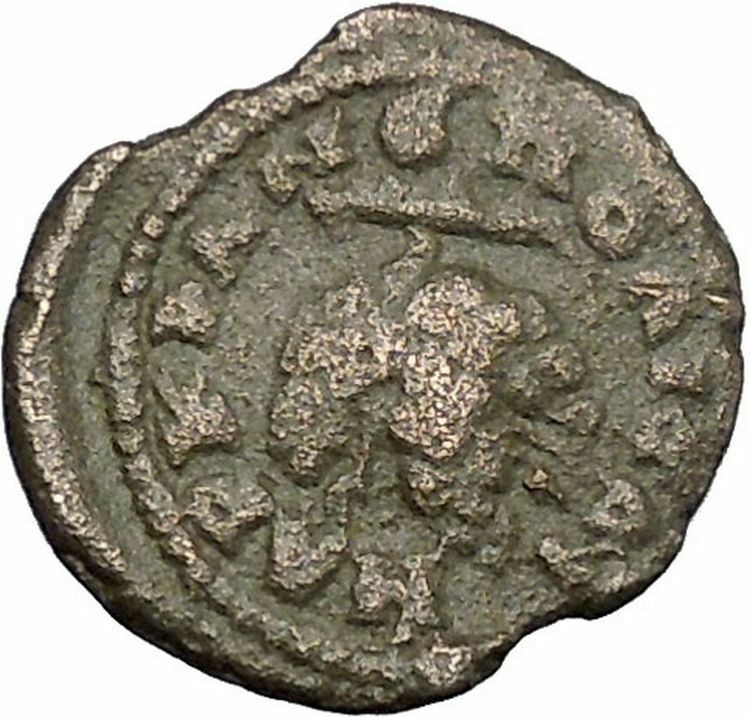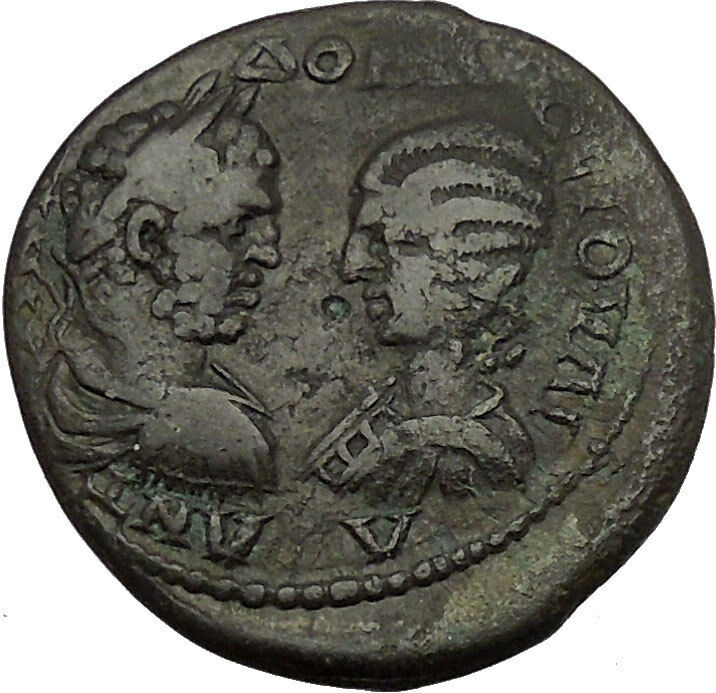|
Antoninus Pius
–
Roman Emperor
: 138-161 A.D.
Bronze 19mm (4.20 grams) of
Philippopolis
in
Thrace
Bare head right.
ΦΙΛΙΠΠΟΠΟΛEΙΤ,
Dionysus standing left, holding thyrsos and kantharos.
You are bidding on the exact
item pictured, provided with a Certificate of Authenticity and Lifetime
Guarantee of Authenticity.

Red-figure
kantharos,
National Archaeological Museum of Athens
.
A kantharos (Greek κάνθαρος) or cantharus is a type of
Greek pottery
used for drinking. It is
characterized by its high swung handles which extend above the lip of the pot.
The god Dionysus
had a kantharos which was never empty.

Geometric
kantharos
In
Greek mythology
, a thyrsus or thyrsos
(Greek:
θύρσος
) was a staff of
giant fennel
(Ferula communis) covered
with ivy
vines and leaves, sometimes wound with
taeniae
and always topped with a
pine
cone
. These staffs were carried by
Dionysus
and his followers.
Euripides
wrote that
honey
dripped from the thyrsos staves that the
Bacchic
maenads
carried.The thyrsus was a sacred
instrument at religious rituals and
fêtes.
Symbolism
The thyrsus, associated with
Dionysus
(or Bacchus) and his followers, the
Satyrs
and
Maenads
, is a symbol of
prosperity
,
fertility
,
hedonism
, and pleasure/enjoyment in general. It
has been suggested that this was specifically a fertility
phallus
, with the fennel representing the shaft
of the penis and the pine cone representing the “seed” issuing forth. The
thyrsus was tossed in the Bacchic dance:
Pentheus: The thyrsus— in my right hand shall I hold it?
-
- Or thus am I more like a Bacchanal?
Dionysus: In thy right hand, and with thy right foot raise it”
Sometimes the thyrsus was displayed in conjunction with a
kantharos
wine cup, another symbol of Dionysus,
forming a male-and-female combination like that of the royal scepter and orb.
Literature
In the Iliad
,
Diomedes
, one of the leading warriors of the
Achaeans
, mentions the thyrsus while speaking
to
Glaucus
, one of the
Lycian
commanders in the
Trojan army, about
Lycurgus
, the king of
Scyros
:
He it was that/drove the nursing women who were in charge/of frenzied
Bacchus through the land of Nysa,/and they flung their thyrsi on the ground
as/murderous Lycurgus beat them with his ox-/goad. (Iliad, Book
VI.132-37)
The thyrsus is explicitly attributed to Dionysus in
Euripides
‘s play
The Bacchae
as part of the costume of the
Dionysian cult.
…To raise my Bacchic shout, and clothe all who respond/ In fawnskin
habits, and put my thyrsus in their hands–/ The weapon wreathed with
ivy-shoots…” Euripides also writes, “There’s a brute wildness in the
fennel-wands—Reverence it well.” (The Bacchae and Other Plays, trans.
by Philip Vellacott, Penguin, 1954.)
Socrates
writes in
Phaedo
:
I conceive that the founders of the mysteries had a real meaning and were
not mere triflers when they intimated in a figure long ago that he who
passes unsanctified and uninitiated into the world below will live in a
slough, but that he who arrives there after initiation and purification will
dwell with the gods. For “many,” as they say in the mysteries, “are the
thyrsus bearers, but few are the mystics,”–meaning, as I interpret the
words, the true philosophers.
In Part II of
Johann Wolfgang von Goethe
‘s
Faust
,
Mephistopheles
tries to catch a
Lamia
, only to find out that she is an
illusion:
Well, then, a tall one I will catch…/And now a thyrsus-pole I
snatch!/Only a pine-cone as its head. (7775-7777)
Sookie Stackhouse notes the thyrsus carried by the maenad in the 2nd book of
The Southern Vampire Mysteries
.
She idly waved the long wand with the tuft on the end. It was called a
thyrsis [sic];
I’d looked maenad up in the encyclopedia. Now I could die educated. (Harris,
Charlaine (2006-09-01). “Living Dead in Dallas: A Sookie Stackhouse Novel”}
Gallery
-
A Bacchant holding a thyrsus: Malice, by
William-Adolphe Bouguereau
, 1899
-
Roman relief showing a Maenad holding a thyrsus (Prado,
Madrid
).
-
Bacchus Triumphant (1882)
by
John Reinhard Weguelin
-
A Maenad uses her thrysos to ward off a Satyr,
Attic red-figure
kylix
, circa 480 BC
Dionysus
is the god of the
grape harvest, winemaking and wine, of ritual madness, fertility, theatre and
religious ecstasy in
Greek mythology
. Alcohol, especially
wine, played an important role in Greek
![2nd century Roman statue of Dionysus, after a Hellenistic model (ex-coll. Cardinal Richelieu, Louvre[1])](https://upload.wikimedia.org/wikipedia/commons/thumb/8/8a/Dionysos_Louvre_Ma87_n2.jpg/200px-Dionysos_Louvre_Ma87_n2.jpg)
culture
with Dionysus being an important reason for this life style. His name, thought
to be a theonym
in
Linear B
tablets as di-wo-nu-so (KH
Gq 5 inscription), shows that he may have been worshipped as early as c.
1500–1100 BC by
Mycenean Greeks
; other traces of the
Dionysian-type cult have been found in ancient
Minoan Crete
. His origins are uncertain, and
his cults took many forms; some are described by ancient sources as Thracian,
others as Greek. In some cults, he arrives from the east, as an Asiatic
foreigner; in others, from
Ethiopia
in the South. He is a god of
epiphany
, “the god that comes”, and his
“foreignness” as an arriving outsider-god may be inherent and essential to his
cults. He is a major, popular figure of
Greek mythology
and
religion
, and is included in some lists of the
twelve Olympians
. Dionysus was the last god to
be accepted into Mt. Olympus. He was the youngest and the only one to have a
mortal mother. His festivals were the driving force behind the development of
Greek theatre
. He is an example of a
dying god
.
The earliest cult images of Dionysus show a mature male, bearded and robed.
He holds a fennel
staff, tipped with a pine-cone and known
as a thyrsus
. Later images show him as a
beardless, sensuous, naked or half-naked androgynous youth: the literature
describes him as womanly or “man-womanish”. In its fully developed form, his
central cult imagery shows his triumphant, disorderly arrival or return, as if
from some place beyond the borders of the known and civilized. His procession
(thiasus)
is made up of wild female followers (maenads)
and bearded
satyrs
with
erect penises
. Some are armed with the
thyrsus, some dance or play music. The god himself is drawn in a chariot,
usually by exotic beasts such as lions or tigers, and is sometimes attended by a
bearded, drunken Silenus
. This procession is presumed to be the
cult model for the human followers of his
Dionysian Mysteries
. In his
Thracian
mysteries, he wears the bassaris
or
fox-skin, symbolizing a new life. Dionysus is represented by city
religions as the protector of those who do not belong to conventional society
and thus symbolizes everything which is chaotic, dangerous and unexpected,
everything which escapes human reason and which can only be attributed to the
unforeseeable action of the gods.
Also known as Bacchus, the name adopted by the
Romans
and the frenzy he induces, bakkheia.
His thyrsus is sometimes wound with ivy and dripping with honey. It is a
beneficent wand but also a weapon, and can be used to destroy those who oppose
his cult and the freedoms he represents. He is also called Eleutherios
(“the liberator”), whose wine, music and ecstatic dance frees his followers from
self-conscious fear and care, and subverts the oppressive restraints of the
powerful. Those who partake of his mysteries are possessed and empowered by the
god himself. His cult is also a “cult of the souls”; his maenads feed the dead
through blood-offerings, and he acts as a divine communicant between the living
and the dead.
In Greek mythology, he is presented as a son of
Zeus and the mortal
Semele
, thus semi-divine or
heroic: and as son of Zeus and
Persephone
or
Demeter
, thus both fully divine, part-chthonic
and possibly identical with
Iacchus
of the
Eleusinian Mysteries
. Some scholars believe
that Dionysus is a
syncretism
of a local Greek nature deity and a
more powerful god from
Thrace
or
Phrygia
such as
Sabazios
or
Zalmoxis
.
Plovdiv (Bulgarian:
Пловдив) is
the second-largest city
in
Bulgaria
with a population of 380,683.
Plovdiv’s history spans some 6,000 years, with traces of a Neolithic settlement
dating to roughly 4000 BC. It is the administrative center of
Plovdiv Province
in southern Bulgaria and three
municipalities (Plovdiv,
Maritsa
and
Rodopi
) and Bulgaria’s
Yuzhen tsentralen
planning region (NUTS II), as
well as the largest and most important city in
Northern Thrace
and the wider international
historical region of
Thrace
. The city is an important economic,
transport, cultural and educational center.
Known in the West for most of its history by the
Greek
name Philippopolis, it was
originally a Thracian
settlement before becoming a major
Roman
city. In the Middle Ages, it retained its
strategic regional importance, changing hands between the
Byzantine
and
Bulgarian Empires
. It came under
Ottoman
rule in the 14th century. In 1878,
Plovdiv was made the capital of the autonomous Ottoman region of
Eastern Rumelia
; in 1885, it became part of
Bulgaria with the
unification
of that region and the
Principality of Bulgaria
.
Plovdiv is situated in the southern part of the Plovdiv Plain on the two
banks of the
Maritsa River
. The city has historically
developed on seven
syenite
hills, some of which are 250 m high.
Because of these seven hills, Plovdiv is often referred to in Bulgaria as “The
City of the Seven Hills”.
There are many remains preserved from
Antiquity
such as the
Ancient amphitheatre
, Roman odeon,
Roman Stadium
, the archaeological complex
Eirene and others.
Plovdiv was given various names throughout its long history. It was
originally a Thracian
settlement by the name of Eumolpias.
Philip II of Macedon
conquered the area in
342-341 BC and renamed the city Philippoupolis (Greek:
Φιλιππούπολις), of which the later Thracian
name for the city, Pulpu-deva, is a reconstructed translation. After the
Romans took control of the area, the city was named
Latin
:
Trimontium, meaning the Three Hills. During the Middle Ages the city
was known as Philippoupolis in
Byzantine Greek
and Paldin (Пълдин) or
Plavdiv (Плъвдив) in
Old Bulgarian
, variations of the town’s earlier
Thracian
name. The city was known as
Philippopolis in Western Europe well into the early 20th century. The city was
known as Filibe in
Turkish
during the
Ottoman Empire
.
Plovdiv has settlement traces dating from the Neolithic, roughly 4000 BC.
Archaeologists have discovered fine pottery and other objects of everyday life
from as early as the Neolithic Age, showing that in the end of the 4th
millennium B.C. there already was an established settlement there. According to
Ammianus Marcellinus
, Plovdiv’s written
post-Bronze Age history lists it as a
Thracian
fortified settlement named Eumolpias.
In 4th century BC the city was a centre of a trade fair (called panegyreis).
In 342 BC, it was conquered by
Philip II of Macedon
, the father of
Alexander the Great
, who renamed it “Φιλιππόπολις”,
Philippopolis or “the city of Philip” in his own honour. Later, it was
reconquered by the
Thracians
who called it Pulpudeva (a
reconstructed translation of Philipopolis)
In 72 AD it was seized by the Roman general Terentius Varo Lukulus and was
incorporated into the
Roman Empire
, where it was called Trimontium
(City of Three Hills) and served as metropolis (capital) of the province
of Thrace
. It gained a city status in late 1st
century. Trimontium was an important crossroad for the Roman Empire and was
called “The largest and most beautiful of all cities” by
Lucian
. Although it was not the capital of the
Province of Thrace, the city was the largest and most important centre in the
province. In those times, the
Via Militaris
(or Via Diagonalis),
the most important military road in the
Balkans
, passed through the city.
“This [Plovdiv] is the biggest and loveliest of all cities. Its
beauty shines from faraway…” |
Roman writer
Lucian
. |
The Roman times were a period of growth and cultural excellence. The ancient
ruins tell a story of a vibrant, growing city with numerous public buildings,
shrines, baths, and theatres. The city had an advanced water system and
sewerage
. It was defended with a double wall.
Many of those are still preserved and can be seen by tourists. Today only a
small part of the ancient city has been excavated.
Titus Aurelius Fulvus Boionius Arrius Antoninus (19 September 86 – 7
March 161), generally known in English as Antoninus Pius was
Roman emperor
from 138 to 161. He was the fourth of the
Five Good Emperors

Antoninus Pius
, Marcus Aurelius’
adoptive father and predecessor as emperor (Glyptothek).
and a member of the
Aurelii
. He
did not possess the
sobriquet
“Pius” until after
his accession to the throne. Almost certainly, he earned the name “Pius” because
he compelled the
Senate
to deify his adoptive father
Hadrian
; the
Historia Augusta
, however, suggests that he may have earned the name by
saving senators sentenced to death by Hadrian in his later years.
//
He was the son and only child of
Titus Aurelius Fulvus
,
consul
in 89
whose family came from
Nemausus
(modern Nîmes
)
and was born near
Lanuvium
and his mother was Arria Fadilla. Antoninus’ father and paternal grandfather
died when he was young and he was raised by
Gnaeus Arrius Antoninus
, his maternal grandfather, a man of integrity and
culture and a friend of
Pliny the Younger
. His mother married to Publius Julius Lupus (a man of
consular rank),
Suffect
Consul
in 98, and bore him a daughter called Julia Fadilla.
As a private citizen between 110 and 115, he married Annia Galeria
Faustina the Elder
. They had a very happy marriage. She was the daughter of
consul
Marcus Annius Verus
and
Rupilia
Faustina (a half-sister to Roman Empress
Vibia
Sabina
). Faustina was a beautiful woman, renowned for her wisdom. She spent
her whole life caring for the poor and assisting the most disadvantaged Romans.
Having filled with more than usual success the offices of
quaestor
and praetor
,
he obtained the consulship in 120; he was next appointed by the Emperor
Hadrian
as
one of the four
proconsuls
to administer
Italia
, then greatly increased his reputation by his conduct as
proconsul
of
Asia
. He acquired much favor with the Emperor Hadrian, who adopted him as
his son and successor on 25 February, 138, after the death of his first adopted
son Lucius Aelius
, on the condition that Antoninus would in turn adopt Marcus
Annius Verus, the son of his wife’s brother, and Lucius, son of Aelius Verus,
who afterwards became the emperors
Marcus Aurelius
and
Lucius
Verus
(colleague of Marcus Aurelius).
Emperor
On his accession, Antoninus’ name became “Imperator Caesar Titus Aelius
Hadrianus Antoninus Augustus Pontifex Maximus”. One of his first acts as Emperor
was to persuade the
Senate
to grant divine honours to Hadrian, which they had at first refused; his efforts
to persuade the Senate to grant these honours is the most likely reason given
for his title of Pius (dutiful in affection; compare
pietas
). Two other reasons for this title are that he would support his
aged father-in-law with his hand at Senate meetings, and that he had saved those
men that Hadrian, during his period of ill-health, had condemned to death. He
built temples, theaters, and mausoleums, promoted the arts and sciences, and
bestowed honours and financial rewards upon the teachers of
rhetoric
and philosophy
.
In marked contrast to his predecessors
Trajan
and
Hadrian
,
Antoninus was not a military man. One modern scholar has written “It is almost
certain not only that at no time in his life did he ever see, let alone command,
a Roman army, but that, throughout the twenty-three years of his reign, he never
went within five hundred miles of a legion”.[2]
His reign was the most peaceful in the entire history of the
Principate
;
while there were several military disturbances throughout the Empire in his
time, in Mauretania
,
Iudaea
, and amongst the
Brigantes
in Britannia
, none of them are considered serious. The unrest in Britannia is
believed to have led to the construction of the
Antonine Wall
from the
Firth of Forth
to the
Firth of Clyde
, although it was soon abandoned. He was virtually unique
among emperors in that he dealt with these crises without leaving Italy once
during his reign, but instead dealt with provincial matters of war and peace
through their governors or through imperial letters to the cities such as
Ephesus (of which some were publicly displayed). This style of government was
highly praised by his contemporaries and by later generations.
Of the public transactions of this period we have scant information, but, to
judge by what we possess, those twenty-two years were not remarkably eventful in
comparison to those before and after his; the surviving evidence is not complete
enough to determine whether we should interpret, with older scholars, that he
wisely curtailed the activities of the Roman Empire to a careful minimum, or
perhaps that he was uninterested in events away from Rome and
Italy
and his
inaction contributed to the pressing troubles that faced not only Marcus
Aurelius but also the emperors of the third century. German historian Ernst
Kornemann has had it in his Römische Geschichte [2 vols., ed. by H. Bengtson,
Stuttgart 1954] that the reign of Antoninus comprised “a succession of grossly
wasted opportunities,” given the upheavals that were to come. There is more to
this argument, given that the Parthians in the East were themselves soon to make
no small amount of mischief after Antoninus’ passing. Kornemann’s brief is that
Antoninus might have waged preventive wars to head off these outsiders.
Scholars place Antoninus Pius as the leading candidate for fulfilling the
role as a friend of Rabbi
Judah
the Prince
. According to the
Talmud
(Avodah
Zarah 10a-b), Rabbi Judah was very wealthy and greatly revered in Rome. He had a
close friendship with “Antoninus”, possibly Antoninus Pius,
who would consult Rabbi Judah on various worldly and spiritual matters.
After the longest reign since Augustus (surpassing
Tiberius
by
a couple of months), Antoninus died of fever at
Lorium
in
Etruria
,
about twelve miles (19 km) from Rome, on 7 March 161, giving the keynote to his
life in the last word that he uttered when the
tribune
of
the night-watch came to ask the password—”aequanimitas” (equanimity). His body
was placed in
Hadrian’s mausoleum
, a
column
was dedicated to him on the
Campus Martius
, and the
temple
he had built in the Forum in 141 to his deified wife Faustina was
rededicated to the deified Faustina and the deified Antoninus.
Historiography
The only account of his life handed down to us is that of the
Augustan History
, an unreliable and mostly fabricated work. Antoninus is
unique among Roman emperors in that he has no other biographies. Historians have
therefore turned to public records for what details we know.
In
later scholarship
Antoninus in many ways was the ideal of the landed gentleman praised not only
by ancient Romans, but also by later scholars of classical history, such as
Edward Gibbon
or the author of the article on Antoninus Pius in the ninth
edition of the
Encyclopedia Britannicaca:
A few months afterwards, on Hadrian’s death, he was enthusiastically
welcomed to the throne by the Roman people, who, for once, were not
disappointed in their anticipation of a happy reign. For Antoninus came
to his new office with simple tastes, kindly disposition, extensive
experience, a well-trained intelligence and the sincerest desire for the
welfare of his subjects. Instead of plundering to support his
prodigality, he emptied his private treasury to assist distressed
provinces and cities, and everywhere exercised rigid economy (hence the
nickname κυμινοπριστης “cummin-splitter”). Instead of exaggerating into
treason whatever was susceptible of unfavorable interpretation, he
spurned the very conspiracies that were formed against him into
opportunities for demonstrating his clemency. Instead of stirring up
persecution against the Christians, he extended to them the strong hand
of his protection throughout the empire. Rather than give occasion to
that oppression which he regarded as inseparable from an emperor’s
progress through his dominions, he was content to spend all the years of
his reign in Rome, or its neighborhood.
|












![2nd century Roman statue of Dionysus, after a Hellenistic model (ex-coll. Cardinal Richelieu, Louvre[1])](https://upload.wikimedia.org/wikipedia/commons/thumb/8/8a/Dionysos_Louvre_Ma87_n2.jpg/200px-Dionysos_Louvre_Ma87_n2.jpg)




